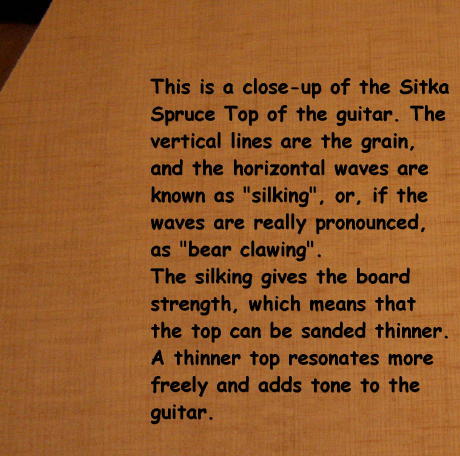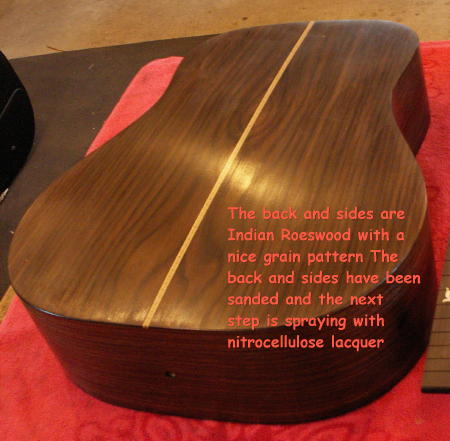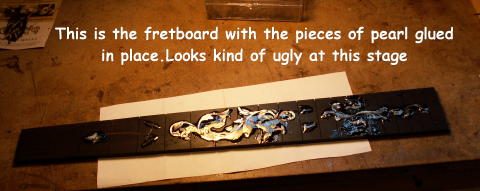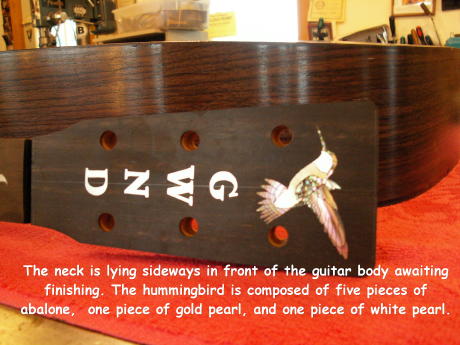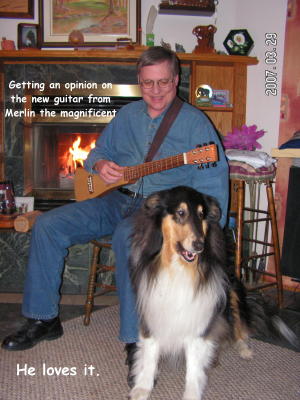Building my first guitar
The back and sides were chosen because I liked the look of the grain pattern. The back came in two pieces that would be edge glued together to form the back of the guitar. Dave told me that I could opt for two possible choices – the straight grain on one side of the two blanks could be edge glued together with the parallel grain side by side, which was the traditional way, or, the curved grain on the other side of the blanks could be edge glued together making a pattern that was symetrical and different. I chose the latter option and I’m still happy with that choice.
There were many steps taken in that course. Dave Nichols was kind enough to get me through the worst of the scary parts where I thought I would wreck all that I’d done so far. In the end, the inlay work on the fingerboard and headstock gives me a lot of pleasure just to look at. The guitar itself plays beautifully and I’m very pleased with it. I play it often, but what sets it apart from other guitars is the inlay work. There isn’t another one like it.
The Inlay Course
The Inlay course at Custom Pearl Inlay started easily enough. Dave Nichols is the guy that runs it. First you have to understand that Dave is really good, he’s been in the business of lutherie and pearl inlay since Adam was a cowboy, he knows an awful lot of people, and he’s pretty down to earth. He only asks that you listen to him, (like really listen), and that you try your best.
Or don’t.
He already knows how to cut pearl, you don’t.
First I started cutting up simple, and small pieces, with relatively few sharp corners. Getting the right angle of view so that you’re focusing on where the blade is going rather than where it’s been is one of the first things you learn. Shortly thereafter you notice that there’s a pain in the small of your back and that you probably should breathe a little more often, and maybe more easily too. So Dave admonishes you to sit straighter, hold youself “so” and relax – this is fun. Apparently one guy tried the course for a day, (it’s a week long course) and said NO, (with several explicatives) and converted over to starting the guitar building course.
It’s not for everybody.
Eventually, I got to the stage that I had some pearl cut, a fretboard routed out to accept the pieces of pearl, and the relatively simple patternn was ready to be glued.
The next step was to sand off the glue with various grades of sandpaper, polish it, and (small leap here) build a guitar around it .
Here’s the cleaned up version. Not bad for a beginner…

- I think it’s that distinctiveness that draws me to doing inlaying – it makes things unique and gives whatever you’ve made a flair that immediately catches the eye of the beholder. Hence the term “Making It Personal”.
- As I was nearing the end of the inlaying course I discovered a pattern for a hummingbird and fell in love with it. I just had to try it, even if I figured that it was way above my skill level. Dave helped a lot, with his advice and soothing words, especially when one of the wing feathers broke. It’s incredibly easy to bust a thin fether that’s attached at only one end. Dave also took pity on me and did the routing on the headstock – there was no way at my skill level at that time that I could have done an acceptable job of the routing.
The GWND stands for the band of which I’m a member – The Grateful We’re Not Dead – we’re a country comedy group that plays for charities. You’re welcome to click on the link to it from this site.
Getting Hooked
In April of 2007 I retired from the Canadian Civil Service. Specifically I worked for the Public Works Government Services Canada department, in the Informatics field. I loved my job, and really enjoyed the people with whom I worked, but it was time to retire and I could feel it. The commute into Ottawa was getting longer each day and there were other things I wanted to do, so retire I did. I won’t say I’ve never looked back, because I have, but in general I’m glad to be retired and doing other things.
One of the first things my wife and I did upon retirement was to go on a short cruise out of LosAngeles. As a retirement gift, I was given a Martin “travel” guitar which I brought along on the cruise and subsequent vist to some of our relatives. While standing in line getting ready to board the ship, a total stranger came up to me and starting chatting about travel guitars. it was great fun; I had never realised that there were so many makes and models of travel guitars. The seeds that had been planted in my brain in my teens were starting to stir.
After the cruise, life returned to more mundane things and what could be more day-to-day than getting a haircut. Sitting in the barber’s chair I mentioned to my barber, Don O’Neil, that I’d like to build my own guitar. Now Don has been a professional musician, as well as a barber, since he was born. I suspect that he came out of the womb playing jazz chords to a country melody. “You should check out Dave Nichols in Malone New York” he said. “He teaches guitar making and he’s one heck of an inlaying artist. Google www.custompearlinlay.com.” So I did, and signed up for the Inlay course as well as the Guitar Building course.
New Home of Inlay Innovations
Welcome
Welcome to the new Inlay Innovations website. Over the coming months (and maybe years) I’ll be expounding on the techniques, delight, and beauty of inlay work using mother of pearl, abalone, and other types of inlay materials.
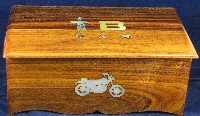
I hope you feel inclined to return frequently to the site to enjoy the art of inlay and to learn about the people involved in the field and their works of art.
Inlay Innovations Mission Statement
- To promote the art of inlay
- To promote inlay artists
- To make contacts in the lutherie field
- To make my inlaying services known to viewers
- To show a variety of possible inlay creations
Bruce
